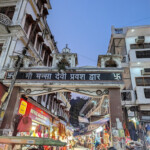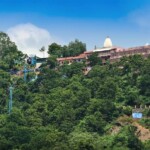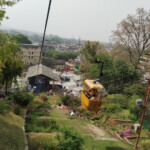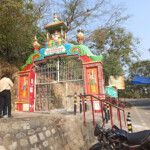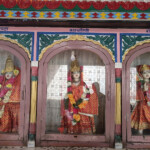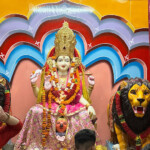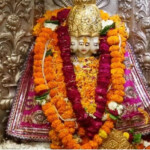
Mansa Devi Temple is a popular Hindu pilgrimage site located in the city of Haridwar, Uttarakhand, India. It is dedicated to the goddess Mansa Devi, who is believed to fulfill the wishes of her devotees. Here is some information about the temple:
Shri Mata Mansa Devi Mandir Haridwar Timings
| Day | Timing |
| Monday | 5:00 am – 9:00 pm |
| Tuesday | 5:00 am – 9:00 pm |
| Wednesday | 5:00 am – 9:00 pm |
| Thursday | 5:00 am – 9:00 pm |
| Friday | 5:00 am – 9:00 pm |
| Saturday | 5:00 am – 9:00 pm |
| Sunday | 5:00 am – 9:00 pm |
Glory of Mansa Devi Temple
The Mansa Devi Temple is a prominent Hindu temple located in the city of Haridwar in the Indian state of Uttarakhand. It is one of the most revered and popular temples in the region, and it holds great significance for devotees who visit it.
Here are some aspects that contribute to the glory and importance of the Mansa Devi Temple:
1. Goddess Mansa Devi:
The temple is dedicated to Goddess Mansa Devi, a form of the Hindu goddess Shakti. Mansa Devi is believed to be the wish-fulfilling goddess who blesses her devotees with their desires and protects them from various troubles and dangers.
2. Ancient History:
The temple has a rich history that dates back several centuries. It is said to have been constructed by the Maharaja of Kashmir in the 11th century, and it has undergone various renovations and reconstructions over the years.
3. Scenic Location:
The temple is situated atop the Bilwa Parvat (Bilwa Hill), providing panoramic views of the city of Haridwar and the Ganges River. The location adds to the temple’s charm and attracts both religious pilgrims and tourists.
4. Rope Way:
To reach the temple, visitors can use a cable car or rope way, known as the Mansa Devi Udankhatola. The ride offers breathtaking views and is a convenient way for devotees to access the temple complex.
5. Festivals and Fairs:
The temple is particularly crowded during the Navratri festival, which is a nine-day celebration dedicated to Goddess Durga. Devotees from all over the country come to the Mansa Devi Temple during this time to seek the goddess’s blessings.
6. Devotee’s Offerings:
Devotees offer coconuts, fruits, incense sticks, and red chunri (cloth) to the goddess as a symbol of their devotion and to seek her blessings.
7. Spiritual Experience:
The Mansa Devi Temple provides a tranquil and spiritual environment for prayer and meditation. It is a place where devotees come to find solace, seek blessings, and connect with their faith.
8. Religious Significance:
Haridwar is one of the seven holiest places in Hinduism, and the Mansa Devi Temple is an integral part of the religious and spiritual fabric of the city. It is often visited by pilgrims on their journey to other sacred destinations in the region.
Overall, the Mansa Devi Temple is not only a place of worship but also a symbol of faith, devotion, and the cultural heritage of the region. It continues to attract visitors from across India and beyond, making it a significant and revered site in Hinduism.
Image Gallery of Mansa Devi Temple Haridwar
Why Mansa Devi Temple is called Siddha Peetha
The Mansa Devi Temple is often referred to as a “Siddha Peetha” because it is believed to be one of the 51 Shakti Peethas in Hindu mythology. The term “Siddha Peetha” has a specific significance in the context of these sacred sites.
Here’s why the Mansa Devi Temple is called a Siddha Peetha:
1. Shakti Peethas:
In Hinduism, Shakti Peethas are a group of sacred shrines dedicated to the goddess Shakti, who represents the divine feminine energy and power. These shrines are associated with the various parts of the body of the goddess Sati, who is believed to have self-immolated due to the disrespect shown to her husband, Lord Shiva.
2. Formation of Shakti Peethas:
According to Hindu mythology, after Sati’s self-immolation, her body parts are said to have fallen at various locations across the Indian subcontinent. Each of these locations became a Shakti Peetha, and each is associated with a specific manifestation of the goddess. The Shakti Peethas are believed to be places where the divine energy of the goddess is particularly powerful.
3. Mansa Devi Temple as a Siddha Peetha:
The Mansa Devi Temple in Haridwar is associated with the head (mukha) of the goddess Sati, and it is considered one of the 51 Shakti Peethas. The term “Siddha Peetha” signifies that this temple is a place where spiritual attainment and blessings are readily available to the devotees. It is believed that by worshiping Mansa Devi at this temple, one can achieve spiritual and material fulfillment, and their wishes and desires can be granted.
4. Spiritual Significance:
As a Siddha Peetha, the Mansa Devi Temple holds a special place in Hindu religious beliefs. Devotees visit the temple to seek the blessings of the goddess and to have their prayers answered. It is considered a place where spiritual goals can be achieved, and where the goddess’s divine grace can be obtained.
The Mansa Devi Temple is known as a Siddha Peetha because it is one of the 51 Shakti Peethas associated with the goddess Sati, and it is believed to be a place where devotees can attain spiritual and material fulfilment, making it a sacred and significant pilgrimage site in Hinduism.
Mansa Devi Temple Opening and Closing Timing
The opening and closing timings of the Mansa Devi Temple in Haridwar may vary throughout the year, and they are subject to change during festivals and special occasions. It’s essential to check the current schedule before planning your visit.
However, as a general guideline, the temple usually follows these timings:
MANSA DEVI MANDIR HOG TIME
- 11 AM to 11:15 AM Daily
MANSA DEVI MANDIR OPENING CLOSING TIME
- Summer Timings: 4 AM to 10 PM
- Winter Timings: 5 AM to 9 PM
MANSA DEVI MANDIR AARTI TIMINGS SUMMER
- Morning: 4:30 AM to 5:00 AM
- Evening: 7:00 PM to 7:30 PM
MANSA DEVI MANDIR AARTI TIMINGS WINTER
- Morning: 5:30 AM to 6:00 AM
- Evening: 6:00 PM to 6:30 PM
These timings can be helpful for planning your visit to the Mansa Devi Temple, ensuring that you have ample time to participate in the various rituals and to seek the blessings of the goddess. Keep in mind that these timings may be subject to change during special festivals or events, so it’s a good practice to verify the schedule before your visit.
Mansa Devi Temple Haridwar Do’s & Don’ts
Here are some important do’s and don’ts for visitors to the Mansa Devi Temple in Haridwar:
Do’s:
- Perform Darshan of the Deity in a queue.
- Use the token system provided by the Shrine Board for Sugam Darshan (convenient and faster darshan).
- Take advantage of the lift facility if you are a senior citizen, divyang (differently-abled), patient, or pregnant lady.
- Keep the temple complex clean and refrain from littering.
- Make advance bookings for rooms at Luxmi Bhawan Dharamshala and Lajwanti Guest House if needed.
- Book Chola (prayer offerings) and Hawan services in advance.
- Consider purchasing packed dry fruit Prasad available in the temple complex.
- Safeguard your valuables and personal belongings.
- Respect the property of the Shrine Board and do not damage it.
Don’ts:
- Smoking, the consumption of non-vegetarian food, and the use of liquor or any intoxicating products are strictly prohibited in the Shrine Complex. These substances are considered impure in a religious context.
- Avoid jumping queues and maintain discipline during darshan.
- Refrain from creating a mess and littering the temple complex.
- Do not damage or deface the property belonging to the Shrine Board.
- Be respectful and maintain decorum while inside the temple premises.
Following these do’s and don’ts is not only a sign of respect for the religious and cultural traditions associated with the Mansa Devi Temple but also contributes to a more harmonious and pleasant experience for all visitors.
Religious Places Near About
The Shri Mata Mansa Devi Temple in Panchkula, Haryana, is surrounded by several other religious and tourist attractions in the region.
Here are some religious places and tourist spots located near the Mansa Devi Temple:
-
Shiv Mandir, Saketri:
This temple is dedicated to Lord Shiva and is located just 5 kilometers from the Shri Mata Mansa Devi Temple. It provides an opportunity for devotees to visit both these sacred places.
-
Gurudwara Nada Sahib, Panchkula:
Gurudwara Nada Sahib, situated 8 kilometers from Mansa Devi Temple, is an important Sikh religious site. It is associated with Guru Gobind Singh Ji and holds historical and religious significance.
The ancient Shri Kali Mata Temple in Kalka is around 18.7 kilometers from the Mansa Devi Temple. It is dedicated to Goddess Kali and attracts devotees from far and wide.
-
Shri Chandi Mata Mandir, Chandi Mandir:
This temple, located 3.1 kilometers from the Mansa Devi Temple, is dedicated to Goddess Chandi. It’s another significant religious site in the vicinity.
-
Yadvindra Gardens, Pinjore:
Yadvindra Gardens, also known as Pinjore Gardens, is a beautiful Mughal-style garden located about 12.3 kilometers from the Mansa Devi Temple. It’s a popular tourist attraction known for its stunning architecture and landscaping.
-
Sukhna Lake, Chandigarh:
Sukhna Lake in Chandigarh is around 10.1 kilometers from the Mansa Devi Temple. While not a religious site, it’s a serene and picturesque location for relaxation and leisure.
Visiting these nearby places can enhance your spiritual and cultural experience in the region while allowing you to explore the natural beauty and historical sites that surround the Mansa Devi Temple.
History of Mansa Devi Temple Haridwar

Legend has it that in the Shivalik Hills, a daily visitor, a cow, would offer milk at three adjoining stones (Pindies) on a hilltop. The local residents noticed these peculiar occurrences and began worshipping what they believed to be three Holy Shilas originating from the forehead of Shri Sati.
As a result of this sacred revelation, a temple was eventually constructed. Maharaja Gopal Singh of Manimajra oversaw the construction of the main Shri Mansa Devi Temple, situated in the Shivalik foothills of the village Bilaspur, within the Tehsil and District of Panchkula, during the years 1811-1815. Not far from the main temple, about 200 meters away, another temple known as the Patiala temple was built by Sh. Karam Singh, the then Maharaja of Patiala, in 1840.
Initially, these temples were under the patronage of the Manimajra State. However, after the merger of princely states into Pepsu, the state government’s support ceased, and the temples were left neglected. The ruler of Manimajra appointed a pujari known as ‘khidmatuzar‘ for the temple, whose duty was to perform the deity’s worship. Following the merger into Pepsu, these pujaris gained independence in managing the temple and its land. Unfortunately, they struggled to maintain the temple or provide adequate facilities for visiting devotees, leading to a gradual deterioration of the temple’s condition. In fact, proper arrangements for pilgrims were almost non-existent.
It is believed that the present-day Mata Mansa Devi temple stands on the spot where the next part of Sati Mata’s head was believed to have fallen. The temple was originally dedicated to Mata Sati. King Gopaldas of Manimajra is said to have constructed a 3-kilometer-long cave from his fort to the temple. He would visit Mother Sati with his queen through this cave. It is said that the temple’s inner sanctum door would only open when the king and his queen arrived.
The Mansa Devi Temple, nestled in the foothills of the Shivalik mountain range, occupies a sprawling area of approximately 100 acres adjacent to the village of Bilaspur, near Mani Majra, in the Panchkula district of Haryana. It has preserved its status as a significant shrine for worshipping Shakti (Mansa Devi), the divine feminine embodiment of the cosmic energy that governs the forces of the universe in Hinduism and Shaktism.
The temple complex, spanning about 100 acres in the Shivalik foothills, features a central attraction where devotees tie sacred threads around a tree to seek blessings and answers to their prayers. The main temple is artistically designed with 38 panels of wall paintings and intricate floral motifs adorning the walls and ceiling. Constructed in the early 19th century under the supervision of Maharaja Gopal Singh, it stands as one of the most renowned Shakti temples in North India.
Shaktism, a widely followed belief in this region, has numerous Mansa Devi shrines in various northern states. Presently, the temple is preserved as a heritage site by the government, and it continues to be a place rich in legends and myths, perpetuating a vibrant and spiritual atmosphere.
How to reach Mansa Devi Temple
The Mansa Devi Temple is located in Haridwar, Uttarakhand, India. To reach the temple, you can follow these directions:
By Road:
- If you are coming from Haridwar City Center: The temple is located approximately 3 kilometers from the city center. You can hire a local taxi, auto-rickshaw, or use public transportation to reach the temple.
By Train:
- The nearest railway station is Haridwar Junction, which is well-connected to major cities in India. From the railway station, you can hire a taxi or an auto-rickshaw to reach the Mansa Devi Temple.
By Air:
- The nearest airport is Jolly Grant Airport in Dehradun, which is approximately 37 kilometres from Haridwar. From the airport, you can hire a taxi to reach the temple.
Cable Car (Mansa Devi Udankhatola):
Once you reach the base of the hill, you can use the Mansa Devi Udankhatola (cable car or rope way) to reach the temple, which is situated atop the Bilwa Parvat (Bilwa Hill). The cable car ride offers breathtaking views and is a convenient way to access the temple. The cable car station is easily accessible from the city center.
Please note that the temple is open during specific hours, so it’s a good idea to check the temple’s opening and closing times, as well as any special events or festivals that may affect visiting hours, before planning your trip. Additionally, make sure to dress modestly and follow any specific guidelines or rules for temple visits to show respect for the religious and cultural traditions.
Mansa Devi Udankhatola (cable car or ropeway) Rate List

The rate list for the Udan Khatola (cable car or ropeway) service at the Mansa Devi Temple in Haridwar is as follows:
- Mansa Devi Ticket: ₹100 per person for a single trip (to or from the temple.
- Mansa Devi + Chandi Devi Ticket: ₹263 per person for a single trip, allowing you to visit both the Mansa Devi Temple and the Chandi Devi Temple.
- Mansa Devi Child Ticket: ₹70 per child for a single trip (to or from the temple. This rate is typically for children.
Please note that these rates are subject to change, and it’s advisable to verify the current ticket prices and any discounts for children or special packages with the temple authorities or the Udan Khatola operators before your visit. Additionally, you can inquire about round-trip ticket options if you plan to return to the base station after visiting the temple.
Google Map for Shri Mata Mansa Devi Mandir Haridwar
FAQs about the Mansa Devi Temple in Haridwar
what is Mansa Devi Temple Timings?
| Day | Timing |
| Monday | 5:00 am – 9:00 pm |
| Tuesday | 5:00 am – 9:00 pm |
| Wednesday | 5:00 am – 9:00 pm |
| Thursday | 5:00 am – 9:00 pm |
| Friday | 5:00 am – 9:00 pm |
| Saturday | 5:00 am – 9:00 pm |
| Sunday | 5:00 am – 9:00 pm |
What are the rates for Mansa Devi Udankhatola (cable car or ropeway)?
- Mansa Devi Ticket: ₹100 per person for a single trip (to or from the temple.
- Mansa Devi + Chandi Devi Ticket: ₹263 per person for a single trip, allowing you to visit both the Mansa Devi Temple and the Chandi Devi Temple.
- Mansa Devi Child Ticket: ₹70 per child for a single trip (to or from the temple. This rate is typically for children.
What is the way to reach Mansa Devi Temple?
There are two ways to reach Manshadevi temple on foot and by ropeway.
What is the Mansa Devi Temple?
The Mansa Devi Temple is a Hindu shrine dedicated to Goddess Mansa Devi, a form of Shakti, located in Haridwar, Uttarakhand, India. It is a significant pilgrimage site for devotees seeking the blessings of the goddess.
How do I reach the Mansa Devi Temple?
The temple is accessible by road from the city center of Haridwar. You can also take a cable car (Udan Khatola) from the base of the hill to reach the temple. Haridwar is well-connected by train and road, making it easily accessible.
What are the temple's opening and closing timings?
The temple's opening and closing timings may vary, but as a general guideline, it is typically open from early morning to late evening. It's advisable to check the current schedule before your visit.
Are there any entry fees to visit the temple?
Yes, there are entry fees for visiting the Mansa Devi Temple. The rates may vary, but there are different ticket options, including special rates for children and combined tickets for multiple temples.
What is the significance of the Mansa Devi Temple?
The temple is dedicated to Goddess Mansa Devi, a form of Shakti, and is believed to grant the wishes of devotees. It is considered a Siddha Peetha and holds spiritual and cultural significance.
Can I visit other temples in the vicinity?
Yes, you can also visit the nearby Chandi Devi Temple and other religious sites. Combined tickets are available for visiting multiple temples.
Are there any do's and don'ts for visitors to the temple?
Yes, visitors are expected to follow certain guidelines, such as dressing modestly, not consuming non-vegetarian food, and refraining from smoking or using intoxicating products within the shrine complex.
Is photography allowed inside the temple?
Photography policies may vary, but it is advisable to check with the temple authorities or signage at the temple for specific rules regarding photography and video recording.
What is the history of the Mansa Devi Temple?
The temple has a rich history, including legends related to the worship of Goddess Mansa Devi. It was constructed by Maharaja Gopal Singh of Manimajra in the early 19th century.
Is there accommodation available near the temple?
Yes, there are accommodations available in Haridwar, including hotels and guesthouses, where you can stay during your visit to the Mansa Devi Temple.


